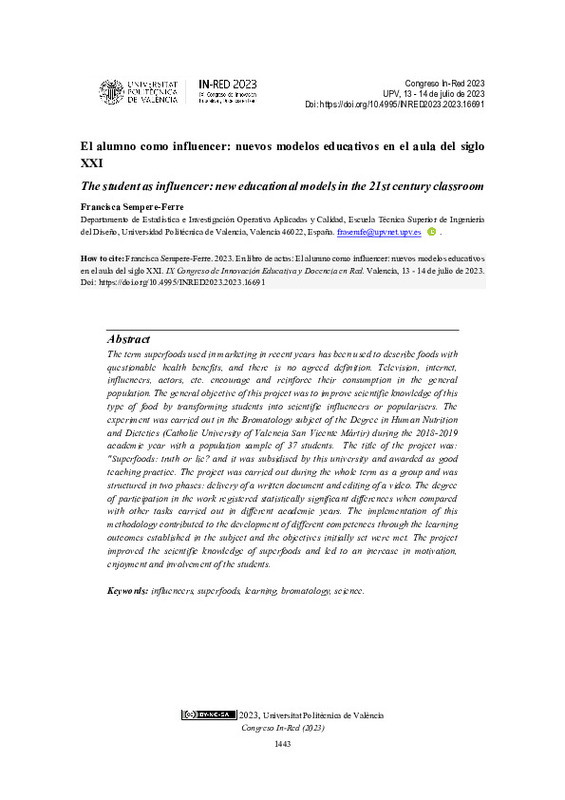JavaScript is disabled for your browser. Some features of this site may not work without it.
Buscar en RiuNet
Listar
Mi cuenta
Estadísticas
Ayuda RiuNet
Admin. UPV
El alumno como influencer: nuevos modelos educativos en el aula del siglo XXI
Mostrar el registro sencillo del ítem
Ficheros en el ítem
| dc.contributor.author | Sempere Ferre, Francisca
|
es_ES |
| dc.date.accessioned | 2023-12-11T12:43:21Z | |
| dc.date.available | 2023-12-11T12:43:21Z | |
| dc.date.issued | 2023-10-06 | |
| dc.identifier.isbn | 9788413960883 | |
| dc.identifier.uri | http://hdl.handle.net/10251/200597 | |
| dc.description.abstract | [EN] The term superfoods used in marketing in recent years has been used to describe foods with questionable health benefits, and there is no agreed definition. Television, internet, influencers, actors, etc. encourage and reinforce their consumption in the general population. The general objective of this project was to improve scientific knowledge of this type of food by transforming students into scientific influencers or popularisers. The experiment was carried out in the Bromatology subject of the Degree in Human Nutrition and Dietetics (Catholic University of Valencia San Vicente Mártir) during the 2018-2019 academic year with a population sample of 37 students. The title of the project was: "Superfoods: truth or lie? and it was subsidised by this university and awarded as good teaching practice. The project was carried out during the whole term as a group and was structured in two phases: delivery of a written document and editing of a video. The degree of participation in the work registered statistically significant differences when compared with other tasks carried out in different academic years. The implementation of this methodology contributed to the development of different competences through the learning outcomes established in the subject and the objectives initially set were met. The project improved the scientific knowledge of superfoods and led to an increase in motivation, enjoyment and involvement of the students. | es_ES |
| dc.description.abstract | [ES] El término superalimentos utilizado a nivel de marketing en los últimos años, se ha utilizado para describir alimentos con beneficios cuestionables sobre la salud, no existiendo una definición consensuada al respecto. Televisión, internet, influencers, actores, etc. propician y refuerzan su consumo en la población en general. El objetivo general de este proyecto fue mejoran el conocimiento cientíco de este tipo de alimentos mediante la transformación de los estudiantes en influencers o divulgadores científicos. El experimento se realizó en la asignatura de Bromatología del Grado de Nutrición Humana y Dietética (Universidad Católica de Valencia San Vicente Mártir) durante el curso académico 2018-2019 con una muestra poblacional de 37 alumnos. El título del proyecto fue: “Superalimentos: ¿verdad o mentira? y fue subencionado por esta universidad y galardonado como buena práctica docente. El proyecto se realizó durante todo el cuatrimestre de forma grupal y se estructuró en dos fases: entrega de un documento escrito y edición de un vídeo. El grado de participación en el trabajo registró diferencias estadísticamente significativas cuando fue comparado con otras tareas realizadas en diferentes cursos académicos. La implementación de esta metodología, contribuyó al desarrollo de diferentes competencias a través de los resultados de aprendizaje establecidos en la asignatura y se cumpliero los objetivos establecidos inicialmente. El proyecto mejoró el conocimiento científico de los superalimentos y produjo un aumento en la motivación, la diversión y la implicación del alumnado. | es_ES |
| dc.format.extent | 10 | es_ES |
| dc.language | Español | es_ES |
| dc.publisher | Editorial Universitat Politècnica de València | es_ES |
| dc.relation.ispartof | In-Red 2023 - IX Congreso Nacional de Innovación Educativa y Docencia en Red | |
| dc.rights | Reconocimiento - No comercial - Compartir igual (by-nc-sa) | es_ES |
| dc.subject | Influencers | es_ES |
| dc.subject | Superalimentos | es_ES |
| dc.subject | Aprendizaje | es_ES |
| dc.subject | Bromatología | es_ES |
| dc.subject | Ciencia | es_ES |
| dc.subject | Superfoods | es_ES |
| dc.subject | Learning | es_ES |
| dc.subject | Bromatology | es_ES |
| dc.subject | Science | es_ES |
| dc.title | El alumno como influencer: nuevos modelos educativos en el aula del siglo XXI | es_ES |
| dc.title.alternative | The student as influencer: new educational models in the 21st century classroom | es_ES |
| dc.type | Capítulo de libro | es_ES |
| dc.type | Comunicación en congreso | es_ES |
| dc.identifier.doi | 10.4995/INRED2023.2023.16691 | |
| dc.rights.accessRights | Abierto | es_ES |
| dc.description.bibliographicCitation | Sempere Ferre, F. (2023). El alumno como influencer: nuevos modelos educativos en el aula del siglo XXI. Editorial Universitat Politècnica de València. 1443-1452. https://doi.org/10.4995/INRED2023.2023.16691 | es_ES |
| dc.description.accrualMethod | OCS | es_ES |
| dc.relation.conferencename | IN-RED 2023: IX Congreso de Innovación Educativa y Docencia en Red | es_ES |
| dc.relation.conferencedate | Julio 13-14, 2023 | es_ES |
| dc.relation.conferenceplace | Valencia, España | es_ES |
| dc.relation.publisherversion | http://ocs.editorial.upv.es/index.php/INRED/INRED2023/paper/view/16691 | es_ES |
| dc.description.upvformatpinicio | 1443 | es_ES |
| dc.description.upvformatpfin | 1452 | es_ES |
| dc.type.version | info:eu-repo/semantics/publishedVersion | es_ES |
| dc.relation.pasarela | OCS\16691 | es_ES |








